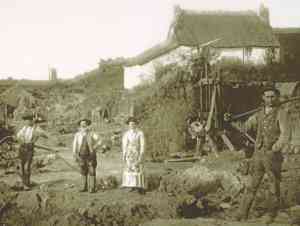Wendron
Click
Here to Return to Home Page
Wendron
(or Gwendron, as it was originally called), (Cornish:
Egloswendron), is situated in the Deanery and Hundred of Kirrier
(Kerrier). It
was originally bounded on the north by Illogan and Gwennap, on the east
by
Stithians and Constantine, on the south by Mawgan and Gunwallow, and on
the
west by Sithney, Crowan and Illogan. The parish of Wendron
stretches
north-east
from the town of Helston which was part of
the parish until 1845. In the past this was an important tin
mining area, and when the mines closed there was severe
unemployment.
In 1878
the landowner, Lord Robartes, tried to ease the situation by bringing
uncultivated land into production.
Long before
recorded history the alluvials of the River Cober were being
worked for tin. The richest areas were the Wendron and Porkellis Valleys, which were the
most important source of alluvial tin in west Cornwall. By the sixteenth
century, underground mining was well established in the district.
The Wendron Mining District was the scene of industrial activity from
prehistoric times until the decline of mining in the late nineteenth
early
twentieth centuries. It has one of the longest histories of tin
working
of any
district within Cornwall and was the most
important source of alluvial tin in west Cornwall. By the 1580's
underground mining was well advanced within the District, it was
recorded
that two of the three most important tin mines in Kerrier were
Roselidden,
later part of the Trumpet Consols group, and Porkellis Mine. The
third
was
'Gorlimoe'. The number of recorded mineral ventures within
Wendron is
640, the
second highest for any mining district in the Duchy however many of the
mines
and stream works date from prehistoric times and there are therefore no
records
of many long forgotten operations. The District is the least researched
in Cornwall. Of the many
hundreds of archaeological surveys of mining sites in the County none
have been
conducted within the Wendron District.

 Click
Here to Return to Home Page
Click
Here to Return to Home Page

